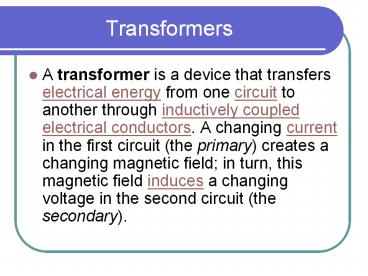Transformers - PowerPoint PPT Presentation
1 / 16
Title:
Transformers
Description:
Transformers A transformer is a device that transfers electrical energy from one circuit to another through inductively coupled electrical conductors. – PowerPoint PPT presentation
Number of Views:274
Avg rating:3.0/5.0
Title: Transformers
1
Transformers
- A transformer is a device that transfers
electrical energy from one circuit to another
through inductively coupled electrical
conductors. A changing current in the first
circuit (the primary) creates a changing magnetic
field in turn, this magnetic field induces a
changing voltage in the second circuit (the
secondary).
2
Transformers
- By adding a load to the secondary circuit, one
can make current flow in the transformer, thus
transferring energy from one circuit to the
other. - The secondary induced voltage VS is scaled from
the primary VP by a factor ideally equal to the
ratio of the number of turns of wire in their
respective windings
3
Step-up or Step-down
- By appropriate selection of the numbers of turns,
a transformer thus allows an alternating voltage
to be stepped up by making NS more than NP or
stepped down, by making it less.
4
Step-up or Step-down
Three-phase pole-mounted step-down transformer.
5
Transformers
- Transformers are some of the most efficient
electrical 'machines',1 with some large units
able to transfer 99.75 of their input power to
their output.2 Transformers come in a range of
sizes from a thumbnail-sized coupling transformer
hidden inside a stage microphone to huge units
weighing hundreds of tons used to interconnect
portions of national power grids. All operate
with the same basic principles, though a variety
of designs exist to perform specialized roles
throughout home and industry.
6
Basic principles
- The transformer is based on two principles
firstly that an electric current can produce a
magnetic field (electromagnetism) and secondly
that a changing magnetic field within a coil of
wire induces a voltage across the ends of the
coil (electromagnetic induction). By changing the
current in the primary coil, it changes the
strength of its magnetic field since the
changing magnetic field extends into the
secondary coil, a voltage is induced across the
secondary.
7
A simplified transformer design is shown to the
left. A current passing through the primary coil
creates a magnetic field. The primary and
secondary coils are wrapped around a core of very
high magnetic permeability, such as iron this
ensures that most of the magnetic field lines
produced by the primary current are within the
iron and pass through the secondary coil as well
as the primary coil.
8
Transformer WEB
http//en.wikipedia.org/wiki/TransformerBasic_pri
nciples
9
Induction law
- The voltage induced across the secondary coil may
be calculated from Faraday's law of induction,
which states that
10
Induction law
- where VS is the instantaneous voltage, NS is the
number of turns in the secondary coil and F
equals the magnetic flux through one turn of the
coil. If the turns of the coil are oriented
perpendicular to the magnetic field lines, the
flux is the product of the magnetic field
strength B and the area A through which it cuts.
11
Induction law
- The area is constant, being equal to the
cross-sectional area of the transformer core,
whereas the magnetic field varies with time
according to the excitation of the primary. Since
the same magnetic flux passes through both the
primary and secondary coils in an ideal
transformer,1 the instantaneous voltage across
the primary winding equals
12
Induction law
- Taking the ratio of the two equations for VS and
VP gives the basic equation5 for stepping up or
stepping down the voltage
13
Ideal power equation
- If the secondary coil is attached to a load that
allows current to flow, electrical power is
transmitted from the primary circuit to the
secondary circuit. Ideally, the transformer is
perfectly efficient all the incoming energy is
transformed from the primary circuit to the
magnetic field and thence to the secondary
circuit. If this condition is met, the incoming
electric power must equal the outgoing power.
Some energy is lost as heat so therefore it is
not 100 efficient- VPIPVSIS
14
Ideal power equation
Thus, if the voltage is stepped up (VS gt VP),
then the current is stepped down (IS lt IP) by the
same factor. In practice, most transformers are
very efficient (see below), so that this formula
is a good approximation
15
Ideal power equation
- Transformer_under_load.svg?
16
Ideal power equation
- The impedance in one circuit is transformed by
the square of the turns ratio.1 For example, if
an impedance ZS is attached across the terminals
of the secondary coil, it appears to the primary
circuit to have an impedance of . This
relationship is reciprocal, so that the impedance
ZP of the primary circuit appears to the
secondary to be .
OR































